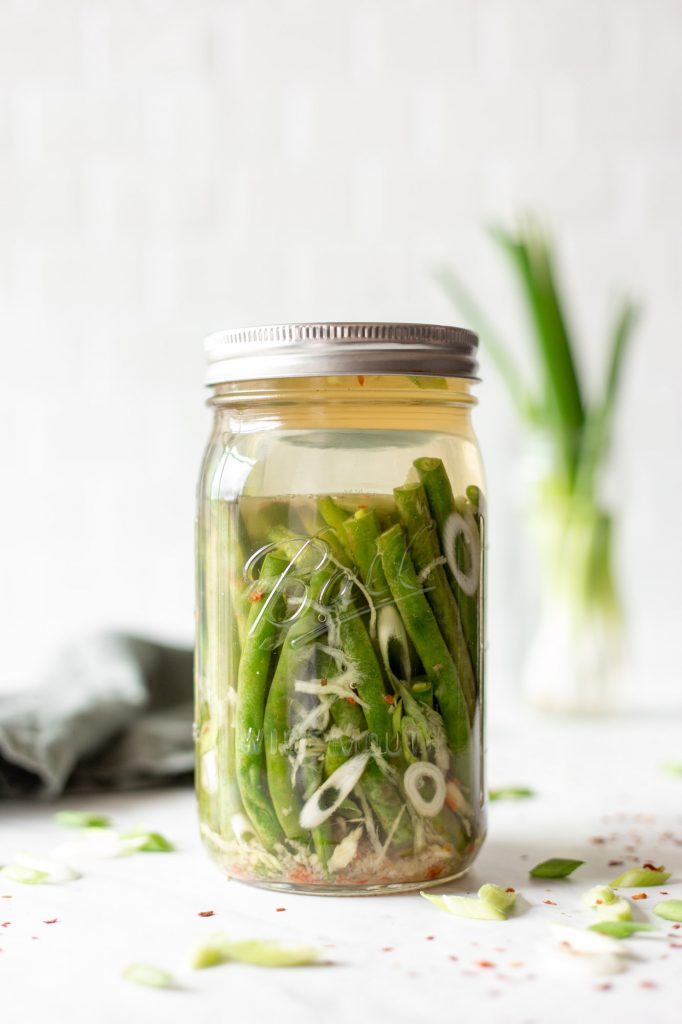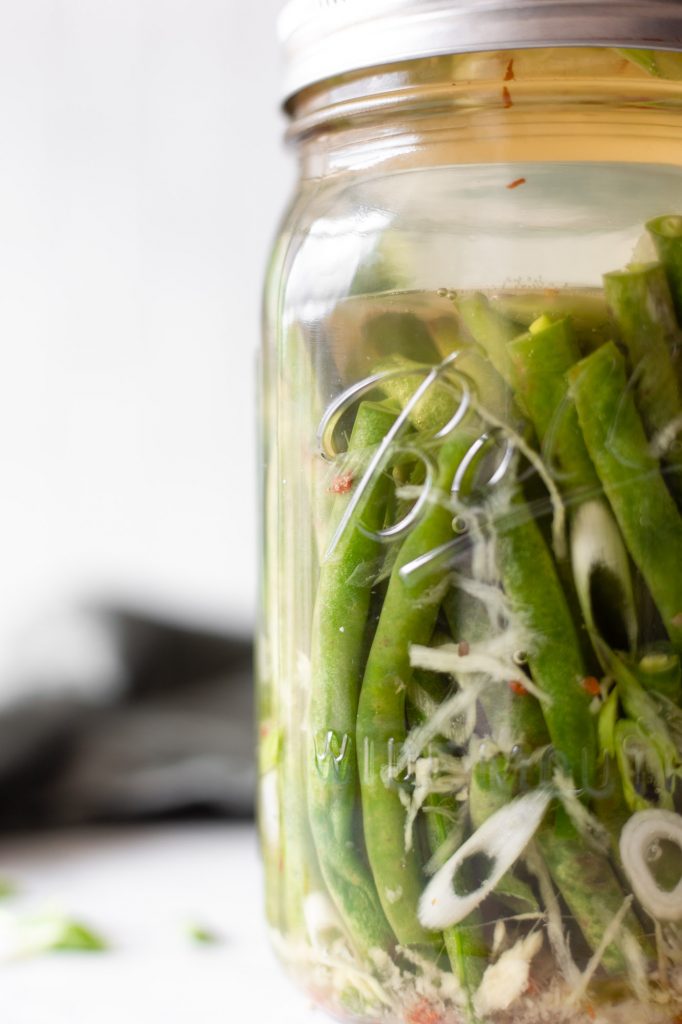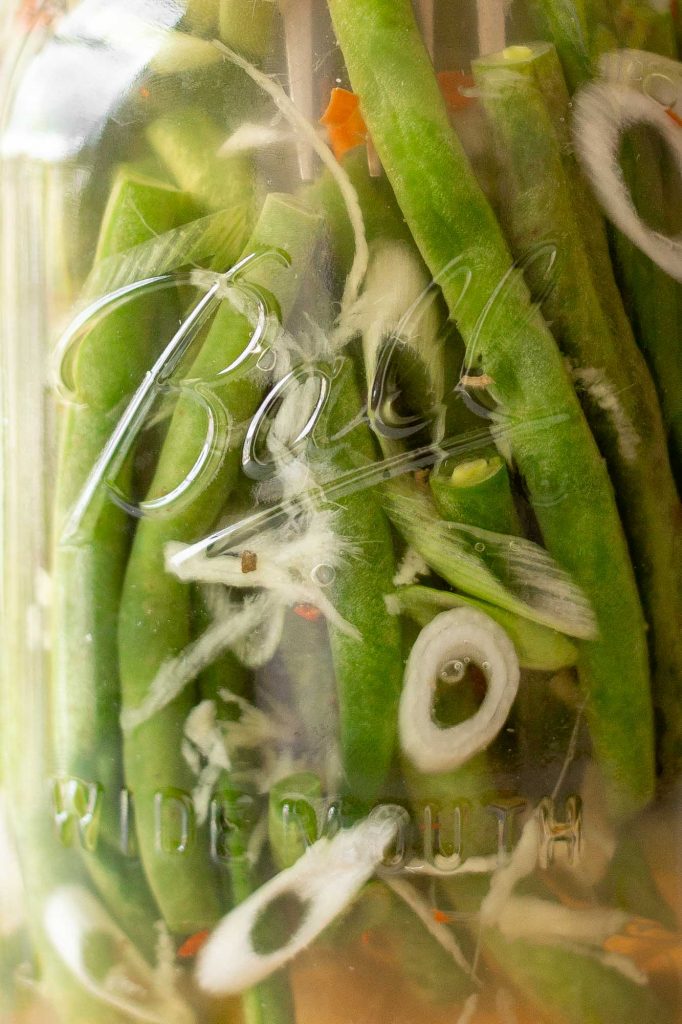Green beans are one of the best and easiest vegetables to ferment! With just salt, water, fresh green beans, spices, a fermentation weight, and a mason jar you can makes these probiotic-packed fermented green beans at home. This recipe requires a kitchen scale for measuring ingredients and two weeks of fermentation at room temperature.
Choosing the Right Green Beans for Fermentation
- Green beans should be purchased untrimmed and loose from the store or farmers’ market. DO NOT buy green beans that have been trimmed, triple washed and packaged in a plastic bag because they will not ferment well.
- Good options for sourcing quality green beans are your local farmers market, Whole Foods Market, sprouts market, and open-aired produce stands. Many grocery stores that have a fresh produce section with vegetables not packaged in plastic also carry fresh green beans.
- Make sure the green beans are crisp, hydrated, and fresh. If you try to bend one in half, it should quickly and easily snap.
- Green beans season in the USA is late spring through early fall, so this will be the easiest time to find fresh green beans.

Equipment You Need to Make Fermented Green Beans
Here’s all the supplies and equipment you will need to make this recipe:
- sea salt
- water (tap works fine, but if your tap water is questionable use filtered)
- 1-quart glass mason jar with lid
- a glass Fermentation Weightfit to the mason jar
- Metal mason jar screw band or Rust Free Plastic Screw Band
- Kitchen scale

How to Make Lacto-Fermented Green Beans
This recipe is simple! The hardest part is waiting two weeks for the fermentation process to finish. Why two weeks? Well, here’s what happens when green beans are fermented for two weeks at about 76° F:
We tracked our fermented green beans throughout the fermentation process. By checking the progress of microbial stages using microscopy we have provided you with this handy timeline! If you follow our recipe and directions, your timeline for lacto-fermented green beans should approximately match ours!
24 – 72 hours: All contents in the jar should be submerged beneath the brine. At this time there are still Gram negative bacteria, yeasts, fungi, and possible pathogens present.
72 hours – 7 days: After 72 hours you should start to see lots of bubbles produced and the green beans will begin to change color. This is the stage in which you will burp the jar. This is when the ferment enters stage two of vegetable fermentation. Leuconostoc bacteria begin to thrive and produce a lot of carbon dioxide. Gram negative organisms from stage one have all died off.
7 – 12 days: The bubbles in the brine will decrease, as the ferment leaves stage two and enters stage three. The mixture will become cloudy and start to develop a pleasantly sour smell. Lactobacillus species are most abundant during this time period.
12 – 14 days: Lactobacillus dominate the microbial population. They produce copious amounts of lactic acid and make the ferment smell even more pleasantly sour. This is the time in which the vegetable mixture becomes preserved. This is when you want to smell and taste test.

Can You Ferment Vegetables That Come in a Bag?
No, you cannot ferment clipped, triple washed green beans that come packaged in a plastic bag.
I do not recommend using triple-washed, pre-chopped vegetables that come in a plastic bag for fermentation.
These vegetables are usually triple-washed, with “vegetable wash” and drying agents, which contain antimicrobial chemicals, sulfates, and phosphates; YES, even if it’s organic. FDA food laws don’t require the packaging to tell you this because the “wash” is considered a food contact substance and not a final product food ingredient.
These washing and drying agents kill most of the friendly microbes on the vegetables. So the microorganisms that facilitate a healthy fermentation process are not present.
Fermented Green Bean Benefits
Have you ever heard of GABA? It stands for Gamma-aminobutyric acid. It is a naturally occurring, non-protein, amino acid that works as a neurotransmitter in your brain. GABA is studied and produced for its multitude of benefits like:
- relieving anxiety
- improving mood
- inhibition of cancer cell proliferation
- reducing symptoms of premenstrual syndrome (PMS)
- aiding in attention deficit-hyperactivity disorder (ADHD) treatment
- lean muscle growth
- stabilizing blood pressure
- relieving muscle pain
Well, it turns out that the microorganisms involved in the lactic acid fermentation of vegetables produce a lot of GABA! This is especially true in fermented cucumbers and fermented green beans. Biologically synthesized GABA, like that produced during fermentation, is more usable by the human body than chemically synthesized GABA. So if you’re feeling like you need a mental wellness boost, try eating some fermented green beans.
The Difference Between Pickled and Fermented Green Beans
Pickling and fermenting are very different processes. Pickling is a sterile process for preserving food. This means there are no microorganisms involved in the pickling process. This process utilizes hot acidic liquid to sterilize and preserve vegetables.
Fermentation is a living process, relying on acid production by beneficial microorganisms. Fermentation takes time and requires a specific salt concentration for consistency and safety. To read more about salt and fermentation click here.
More Fermentation Recipes to Try
- Simple Wild Fermented Shallots Recipe
- Learn How to Ferment Green Tomatoes
- Wild Fermented Dill Pickles
The Best Lacto-Fermented Green Beans with Ginger and Scallions
Green beans are one of the best and easiest vegetables to ferment! With just salt, water, fresh green beans, spices, a fermentation weight, and a mason jar you can makes these probiotic-packed fermented green beans at home. This recipe requires a kitchen scale for measuring ingredients and two weeks of fermentation at room temperature.
- Prep Time: 10 minutes
- Fermentation Time: 2 weeks
- Total Time: 336 hours 10 minutes
- Yield: 8 servings
- Category: Fermented Vegetables
- Method: Fermentation
- Diet: Vegan
Ingredients
- 300 grams fresh green beans
- 550 grams water
- 10 grams grated ginger root
- 30 grams scallions, chopped
- A pinch of red pepper flakes
- 32 grams sea salt
Instructions
- Cut the ends off the green beans and rinse them well in cool water.
- Dissolve the 32 grams of sea salt in 550 grams of water.
- Add the green beans, ginger, and scallions to the 1-quart mason jar, and fill the jar with the water and salt mixture.
- Place your fermentation weight in the jar and make sure the weight and all the green beans are submerged in the salt brine.
- Place the mason jar lid on the jar and secure it closed.
- Allow for fermentation at room temperature for 2 weeks.
- During the first three days, expect a lot of carbon dioxide production. You will need to gently open the jar lid to let some of the gas out daily. At the one week mark, you should notice the bubbles decreasing and eventually stopping completely at two weeks.
- Check the pH at two weeks to ensure it is below four. Once it is, store the fermented green beans in the fridge.
Notes
- This recipe is sized to fit a 32-ounce mason jar at 1x.
- I suggest using a wide-mouth mason jar.
- It’s best to set the fermentation jar in a glass baking dish to catch any liquid that seeps out while it’s bubbling.
- The green beans will keep in the fridge for a year or two.
Keywords: green beans, fermented
The post The Best Lacto-Fermented Green Beans with Ginger and Scallions appeared first on Cultured Guru.
-------------------------
By: Kaitlynn Fenley
Title: The Best Lacto-Fermented Green Beans with Ginger and Scallions
Sourced From: cultured.guru/blog/the-best-lacto-fermented-green-beans-with-ginger-and-scallions?utm_source=rss&utm_medium=rss&utm_campaign=the-best-lacto-fermented-green-beans-with-ginger-and-scallions
Published Date: Thu, 16 Sep 2021 14:32:55 +0000
.png)








